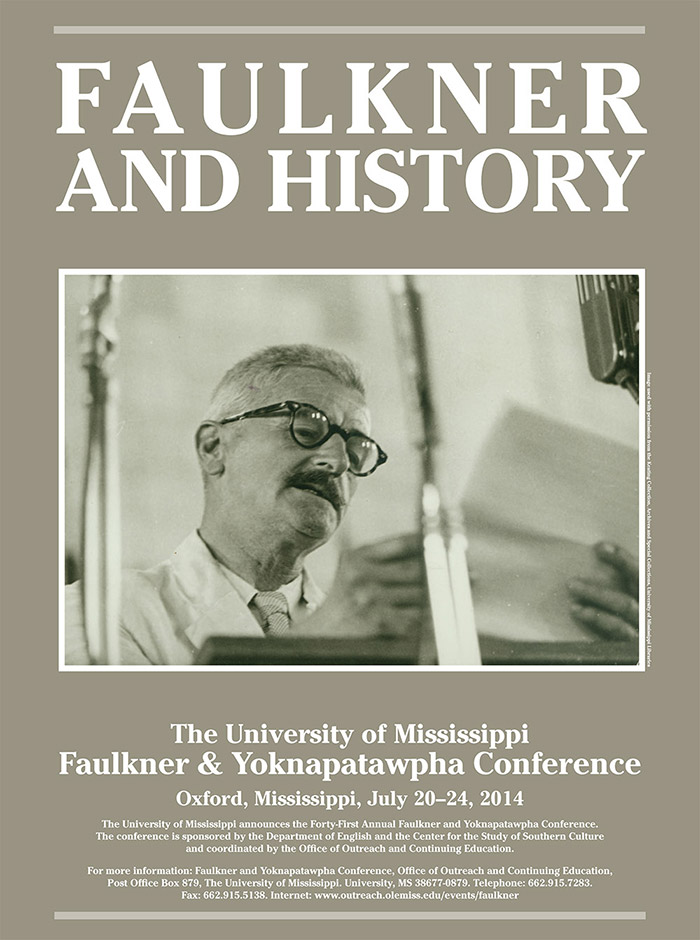
Panel. Faulkner, Modern Art, and Modern War
Location
Nutt Auditorium
Start Date
22-7-2014 11:00 AM
Description
- The Searching Solder: Faulkner's Appropriations of World War I / Serena Blount, University of Alabama
In a brief survey of texts with WWI backdrops and references, this author explores Faulkner's interest in returns and repetitions as a means of demonstrating higher concerns about authorship, writing, and speech. Faulkner's WWI soldiers often revisit and repeat their war struggles. The trauma of war, and often the experiences that lead to traumatic crisis are recounted and revisited by these soldiers. Survey includes "The Lilacs," "Victory," "Crevasse," "The Leg," and a brief look at As I Lay Dying. - The Great War in Disguise: Faulkner, Cubism, and Camouflage / Randall S. Wilhelm, Anderson University
My paper examines Faulkner’s war stories within the aesthetic and historical contexts of cubism and World War I. The double-lens of camouflage (one creates a pattern both to avoid being seen and to allow one to see others undetected) creates new ways of seeing Faulkner’s cubism from a military perspective, blending art and war, two of his most enduring thematic concerns. Emerging nearly simultaneously, camouflage closes the gap between the battlefield and the museums. Modern art and modern warfare share the same sense of surprising and ferocious violence, of speed and chaos, of stilled moments and numbing introspection, of nationalistic fervor and subsequent disillusionment. Employing Cubist theory to Faulkner’s World War I stories offers a glimpse into the aesthetic and philosophical implications behind the trope of deception and the fear and trauma underlying it, the terror of abstraction and non-being for which camouflage serves as mediator. - Canned Art / Violable Interiors: Faulkner's Secret Russian and the Aesthetic of Cold War Containment / Candace Waid, University of California, Santa Barbara
This paper focuses on the rise of V. K. Ratliff, the secret Russian in The Hamlet, situating him in the context of Faulkner’s life-long obsessions with vessels of art and female sexuality, as well as Faulkner’s entry into the Cold War in his post-World War II novels. The Cold War context is also seen in the repeated staging of scenes of social justice in front of patterned backdrops of factory-produced, labelled cans. Backdrops, visually rendered as real or imagined, these walls of cans configure more than a metaphoric iron curtain: these containers literalize fears of sexual and racial contamination, adultery and adulteration, the fetishization of the preserved, the unattainable, and the dead. Hermetically-sealed, the cans picture the threat of contamination delayed (yet acknowledged) by containment. This Cold War ideology finally signifies Ratliff’s home-cooked critique of isolationism, the hoarding of life (“gal meat”) in the cold, if killing, pursuit of cultural purity.
Relational Format
Conference proceeding
Recommended Citation
Blount, Serena; Wilhelm, Randall S.; and Waid, Candace, "Panel. Faulkner, Modern Art, and Modern War" (2014). Faulkner and Yoknapatawpha Conference. 16.
https://egrove.olemiss.edu/fy/2014/schedule/16
COinS
Jul 22nd, 11:00 AM
Panel. Faulkner, Modern Art, and Modern War
Nutt Auditorium
- The Searching Solder: Faulkner's Appropriations of World War I / Serena Blount, University of Alabama
In a brief survey of texts with WWI backdrops and references, this author explores Faulkner's interest in returns and repetitions as a means of demonstrating higher concerns about authorship, writing, and speech. Faulkner's WWI soldiers often revisit and repeat their war struggles. The trauma of war, and often the experiences that lead to traumatic crisis are recounted and revisited by these soldiers. Survey includes "The Lilacs," "Victory," "Crevasse," "The Leg," and a brief look at As I Lay Dying. - The Great War in Disguise: Faulkner, Cubism, and Camouflage / Randall S. Wilhelm, Anderson University
My paper examines Faulkner’s war stories within the aesthetic and historical contexts of cubism and World War I. The double-lens of camouflage (one creates a pattern both to avoid being seen and to allow one to see others undetected) creates new ways of seeing Faulkner’s cubism from a military perspective, blending art and war, two of his most enduring thematic concerns. Emerging nearly simultaneously, camouflage closes the gap between the battlefield and the museums. Modern art and modern warfare share the same sense of surprising and ferocious violence, of speed and chaos, of stilled moments and numbing introspection, of nationalistic fervor and subsequent disillusionment. Employing Cubist theory to Faulkner’s World War I stories offers a glimpse into the aesthetic and philosophical implications behind the trope of deception and the fear and trauma underlying it, the terror of abstraction and non-being for which camouflage serves as mediator. - Canned Art / Violable Interiors: Faulkner's Secret Russian and the Aesthetic of Cold War Containment / Candace Waid, University of California, Santa Barbara
This paper focuses on the rise of V. K. Ratliff, the secret Russian in The Hamlet, situating him in the context of Faulkner’s life-long obsessions with vessels of art and female sexuality, as well as Faulkner’s entry into the Cold War in his post-World War II novels. The Cold War context is also seen in the repeated staging of scenes of social justice in front of patterned backdrops of factory-produced, labelled cans. Backdrops, visually rendered as real or imagined, these walls of cans configure more than a metaphoric iron curtain: these containers literalize fears of sexual and racial contamination, adultery and adulteration, the fetishization of the preserved, the unattainable, and the dead. Hermetically-sealed, the cans picture the threat of contamination delayed (yet acknowledged) by containment. This Cold War ideology finally signifies Ratliff’s home-cooked critique of isolationism, the hoarding of life (“gal meat”) in the cold, if killing, pursuit of cultural purity.

